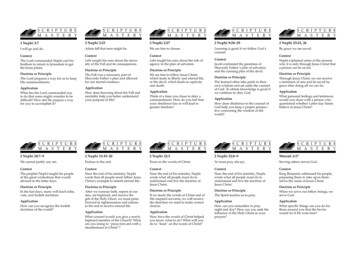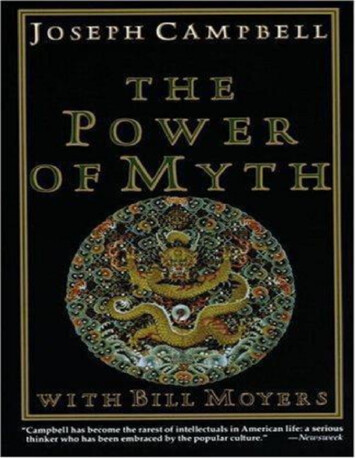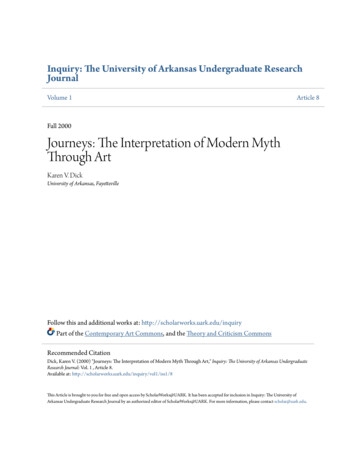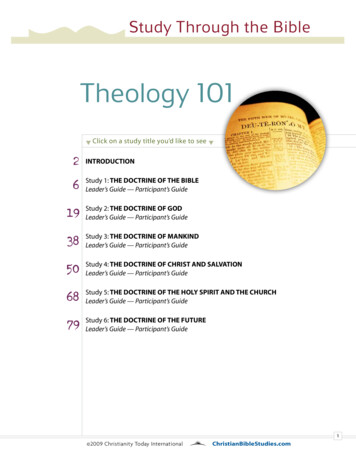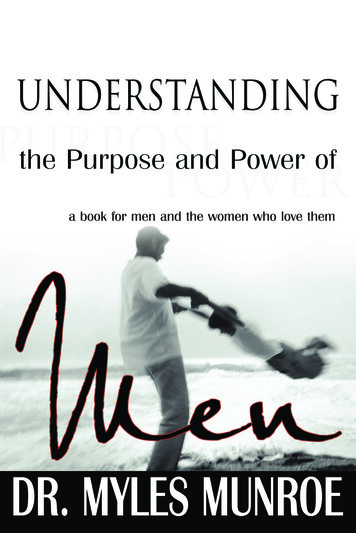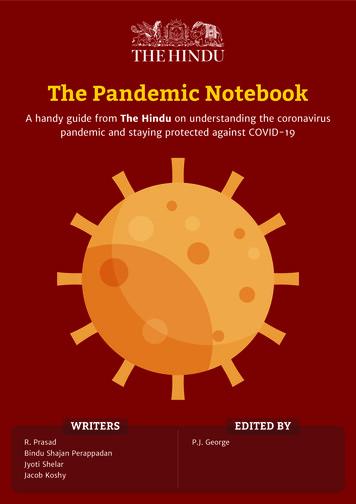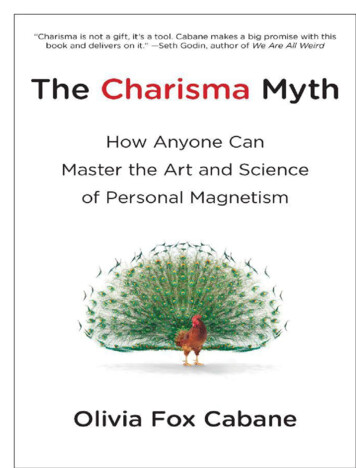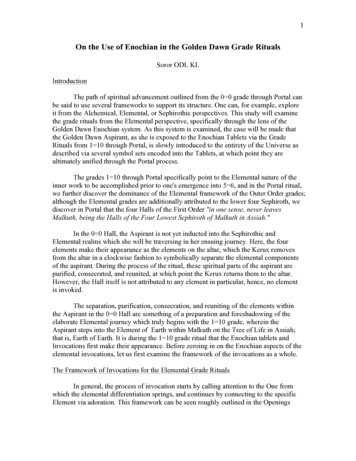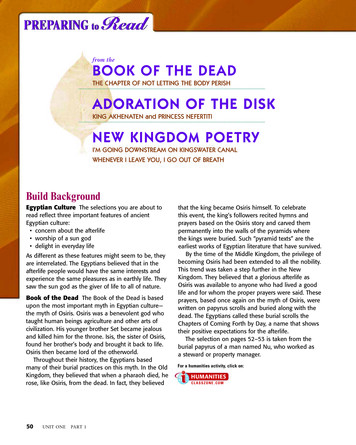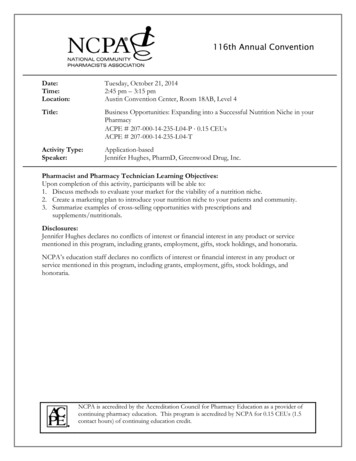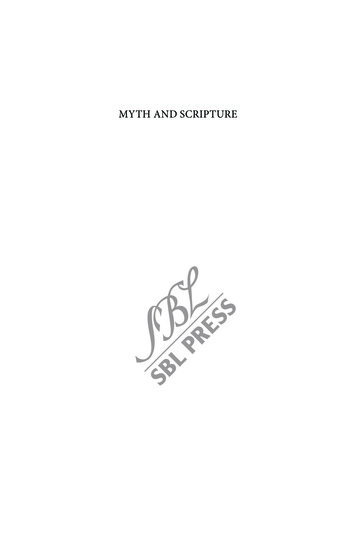
Transcription
Myth and Scripture
Resources for Biblical StudySusan Ackerman, Old Testament/Hebrew Bible EditorNumber 78
Myth and ScriptureContemporary Perspectives on Religion,Language, and ImaginationEdited byDexter E. Callender Jr.SBL PressAtlanta
Copyright 2014 by SBL PressAll rights reserved. No part of this work may be reproduced or transmitted in any formor by any means, electronic or mechanical, including photocopying and recording, or bymeans of any information storage or retrieval system, except as may be expressly permitted by the 1976 Copyright Act or in writing from the publisher. Requests for permissionshould be addressed in writing to the Rights and Permissions Office, Society of BiblicalLiterature, 825 Houston Mill Road, Atlanta, GA 30329 USA.Library of Congress Cataloging-in-Publication DataMyth and scripture : contemporary perspectives on religion, language, and imagination /Dexter E. Callender, Jr., editor.p. cm. — (Society of Biblical Literature resources for biblical study ; Number 78)Includes bibliographical references and index.ISBN 978-1-58983-961-8 (paper binding : alk. paper) — ISBN 978-1-58983-962-5(electronic format) — ISBN 978-1-58983-963-2 (hardcover binding : alk. paper)1. Myth in the Bible. 2. Bible. Old Testament—Criticism, interpretation, etc. I. Callender, Dexter E., 1962– editor of compilation. II. Callender, Dexter E., 1962– author.Myth and Scripture : dissonance and convergence.BS520.5.M98 2014220.6'8—dc232014002897Printed on acid-free, recycled paper conforming toANSI/NISO Z39.48-1992 (R1997) and ISO 9706:1994standards for paper permanence.
ction: Scholarship between Myth and ScriptureDexter E. Callender Jr. and William Scott Green.1Part 1: Myth in the Hebrew Bible and the Ancient Near East“Myth” in the Old TestamentJ. W. Rogerson.15Myth and Scripture: Dissonance and ConvergenceDexter E. Callender Jr. .27Covenant and Contingence: The Historical Encounter betweenGod and IsraelRobert S. Kawashima.51Is Genesis 1 a Creation Myth? Yes and NoMark S. Smith.71Moses’ DeathSusan Ackerman.103Myth and Social Realia in Ancient Israel: Early Hebrew Poemsas Folkloric AssemblageHugh R. Page Jr.119Myth and History in Ezekiel’s Oracle Concerning Tyre(Ezekiel 26–28)Marvin A. Sweeney.129
vicontentsMyth and History in Daniel 8: The Apocalyptic Negotiationof PowerAmy C. Merrill Willis.149Part 2: Myth in the New Testamentand the Greco-Roman WorldRecast, Reclaim, Reject: Myth and ValiditySteven J. Kraftchick.179“God Was in Christ”: 2 Corinthians 5:19 and Mythic LanguageLuke Timothy Johnson.201Ancient Greek DemythologizingJames E. Miller.213Myth, Allegory, and the Derveni PapyrusJohn T. Fitzgerald.229Part 3: Myth Theorizing and the Bible: A ConversationThe Life of King Saul as MythRobert A. Segal.245Response to Robert A. Segal, “The Life of King Saul as Myth”Adela Yarbro Collins.275Theory of Myth and the Minimal SaulIvan Strenski.279The Indispensability of Theories of Myth for Biblical Studies:A Response to Robert SegalDavid L. Miller.285Replies to Ivan Strenski, Adela Yarbro Collins, and David MillerRobert A. Segal.291Contributors.297Index of Primary Sources.301Index of Authors.310
AcknowledgmentsOf the many expressions of gratitude that one might reasonably voicehere, I would be remiss not to acknowledge the efforts and influenceof Neal Walls, my original co-editor of this volume, who was called toadministrative responsibilities that made it impossible for him to continuewith the project. Such are the vicissitudes of academic life. Neal’s ownseminal writings on ancient Near Eastern myth, particularly in Desire,Discord, and Death, exemplify the kind of breadth of knowledge, depthof analysis, creativity, and interdisciplinary resourcefulness increasinglyneeded in biblical studies. Our discussions over the years led to the Society of Biblical Literature’s Bible, Myth, and Myth Theory program unit (areincarnation of sorts of earlier efforts under the auspices of the AmericanAcademy of Religion in the 1970s and again in the 1990s, whose fruitsinclude the now classic Myth and Method, edited by Laurie Patton andWendy Doniger), which Neal and I co-chaired for several years and whichcontinues to thrive today under the leadership of Robert Kawashima(another contributor to this volume) and Stephen Russell.This volume is the culmination of a collaborative research projectbetween members of the Society of Biblical Literature and the American Academy of Religion and owes much to the participation of AARstalwarts Robert A. Segal, Ivan Strenski, David L. Miller, and WilliamScott Green, who have joined together with members of the SBL, manyof whose names are instantly recognizable and all of whom are to bethanked for their efforts. For editorial advice and assistance in preparing this volume for publication, I wish to thank John T. Fitzgerald, myformer colleague at the University of Miami. Finally, thanks are in orderto North-West University in Potchefstroom, South Africa, whose researchassistance helped make the completion of this volume possible.-vii-
AbbreviationsAB Anchor BibleABDAnchor Bible Dictionary. Edited by D. N. Freedman. 6vols. New York: Doubleday, 1992.AJPAmerican Journal of PhilologyAnBib Analecta biblicaANETAncient Near Eastern Texts Relating to the Old Testament.Edited by J. B. Pritchard. 3rd ed. Princeton: PrincetonUniversity Press, 1969.AOAT Alter Orient und Altes TestamentATD Das Alte Testament DeutschBABiblical ArchaeologistBASORBulletin of the American Schools of Oriental ResearchBDAGW. Bauer, F. W. Danker, W. F. Arndt, and F. W. Gingrich.Greek-English Lexicon of the New Testament and OtherEarly Christian Literature. 3rd ed. Chicago: University ofChicago Press, 2000.BRevBible ReviewBZAWBeihefte zur Zeitschrift für die alttestamentliche WissenschaftCivilizations of the Ancient Near East. Edited by J. Sasson.CANE4 vols. New York: Scribner, 1995.CBET Contributions to Biblical Exegesis and TheologyCBQCatholic Biblical QuarterlyCBQMS Catholic Biblical Quarterly Monograph SeriesCC Continental CommentariesCOSThe Context of Scripture. Edited by W. W. Hallo. 3 vols.Leiden: Brill, 1997– 2002.CPClassical Philology-ix-
xAbbreviationsDK Hermann Diels and Walther Krantz, eds. and trans. DieFragmente der Vorsokratiker: Griechisch und Deutsch. 7thed. 3 vols. Berlin: Weidmann, 1954.EREncyclopedia of Religion. Edited by Mircea Eliade. 16 vols.New York: Macmillan, 1987.FATForschungen zum Alten TestamentFGrHistDie Fragmente der griechischen Historiker. Edited by FelixJacoby. Leiden: Brill, 1954–1964.FOTLForms of the Old Testament LiteratureHALOTL. Koehler, W. Baumgartner, and J. J. Stamm, Hebrew andAramaic Lexicon of the Old Testament. Translated andedited by M. E. J. Richardson. 5 vols. Leiden: Brill, 1994–2000.HSM Harvard Semitic MonographsHTRHarvard Theological ReviewHUCAHebrew Union College AnnualIBC Interpretation: A Bible Commentary for Teaching andPreachingICC International Critical CommentaryIntInterpretationIOSIsrael Oriental StudiesJAOSJournal of the American Oriental SocietyJBLJournal of Biblical LiteratureJNESJournal of Near Eastern StudiesJewish Quarterly ReviewJQRJRJournal of ReligionJSOTJournal for the Study of the Old TestamentJSOTSupJournal for the Study of the Old Testament SupplementSeriesJournal for the Study of the Pseudepigrapha SupplementJSPSupSeriesJournal of Theological StudiesJTSDie keilalphabetischen Texte aus Ugarit. Edited by M.KTUDietrich, O. Loretz, and J. Sanmartín. AOAT 24/1. Neukirchen-Vluyn: Neukirchener, 1976.LCL Loeb Classical LibraryLHBOTS Library of Hebrew Bible/Old Testament StudiesMARIMari: Annales de recherches interdisciplinairesNCBC New Century Bible Commentary
AbbreviationsxiNICOT New International Commentary on the Old TestamentOTLOld Testament LibraryRBRevue bibliqueRIH Ras Ibn Hani (excavation number)RSV Revised Standard VersionSBLSociety of Biblical LiteratureSBLDSSBL Dissertation SeriesSBLWAWSBL Writings from the Ancient WorldSBTStudies in Biblical TheologySHCANEStudies in the History and Culture of the Ancient NearEastSJLAStudies in Judaism in Late AntiquitySJOTScandinavian Journal of the Old TestamentVTVetus TestamentumVTSup Vetus Testamentum SupplementsWBCWord Biblical CommentaryZAWZeitschrift für die alttestamentliche WissenschaftZPEZeitschrift für Papyrologie und Epigraphik
Introduction:Scholarship between Myth and ScriptureDexter E. Callender Jr. and William Scott GreenIntroductionThis is a book about how scholars make sense of what we study.1 As a fieldof research whose primary focus is a fixed and finite set of data, biblicalstudies innovates less by discovering new objects of study than by finding fresh ways—or refining old ways—to examine its basic subject matter.Scholars investigate by designing categories of analysis and interpretation to achieve understanding. Regular assessment of the value of thesecategories—however recondite it may appear to a field’s outsiders—provokes scholarly self-consciousness and thereby strengthens the quality ofresearch and advances knowledge.“Myth” and “scripture” are two established categories used to describeand analyze the Hebrew Bible and the New Testament. Each has figuredprominently as a way of rendering the meaning or “truth” of human experience. Myth is an established category in the academic humanities andsocial sciences, particularly in classics, literature, anthropology, and religion. For the purposes of this volume, scripture is a generic native category that biblically based religions use to depict themselves, though somescholars apply it to other religions as well.2Religions typically claim that there is an order to existence—usuallythe work of deities or other superhuman beings—that humans did notmake and in principle cannot change. For instance, the creation accounts1. This volume was completed with generous research assistance from NorthWest University, Potchefstroom, South Africa.2. For a concise comprehensive overview of the category, see Graham 1987; forJudaism and Christianity, see esp. pp. 135–36.-1-
2Myth and Scriptureof the Hebrew Bible and New Testament do not suggest that humansplayed any role in shaping the structure of reality, creating light and darkness, time and space, day and night, or in making the “Word” becomeflesh. For its adherents, a religion’s cosmic order establishes the givens ofexistence and constitutes the prerequisites of human experience.In religion, the cosmic structure is objective, factual, true, and—mostimportant—normative. Religion assumes that humans on their own are,can be, or will be out of sync with the normative cosmic order and thesuperhuman beings who generated it. Religion further claims to knowhow to correct and prevent this inconsonance. Full and proper knowledgeand understanding of this dynamic is highly specific, if not exclusive, toa religion itself. Religions aver that only by adhering to their own specificand distinctive teachings, which entail proper interactions with its deitiesor other superhuman beings, can humans either prevent or repair a breachwith the created order. Religions teach their adherents why and how theworld should work as it does, what humans should do to live in accordwith that normative structure, and what will happen to them if they door do not do so. The validity of a religion’s specialized claims about thecosmos comes from the experience of living them.Each religion has its own particular sources of authority—texts,canons of scripture, revelations, sages, enlightened ones, prophets, chainsof tradition, and so on—that reveal, transmit, and certify its privilegedknowledge of the cosmic order.3 In the biblically based religions, thewritings generically designated as “scripture” (Torah, Tanak, Testament,Gospel, Word of God, the Bible, etc.) constitute one—perhaps the preeminent—source of authority.4 “Scripture” thus constitutes the religiouscommunity’s charter account of the cosmic order and provides guidanceon how to conform to it.It is a scholarly commonplace that a “scripture” has authority becausea community grants it. There are no inherent or required literary traitsor genres that define or constitute “scripture.” Biblical texts include narrative, law, poetry, oracles, genealogies, letters, among other forms. Religions mark the distinctiveness of “scripture” both in their claims aboutand in their use of such texts. In biblically based religions, for instance,3. This and the preceding two paragraphs are drawn from Green 2010.4. As Dexter Callender points out, at Sinai, the deity—the God of Israel—transforms divine speech into writing, and the writing becomes both the emblem andrepository of the deity’s power and wisdom.
callender and Green: Introduction3“scripture” is not only a source of instruction and inspiration but also aroutine component of prayer and liturgy. It can serve as a sacred artifactthat evokes special behavior. In Judaism, the Torah Scroll is an object ofveneration. Roman Catholic priests remove their skullcaps in the presenceof the Gospel, and Lutherans rise when the Gospel is read during worship. Secular legal or political documents elicit no comparable responseor action because they are both devised and alterable by human beingsalone. “The Word of God” makes a broader claim to legitimacy than does“the consent of the governed.” The President of the United States swearsloyalty to the Constitution on the Bible. Our society would regard thereverse as ludicrous.If “scripture” is a relatively settled native category of religion, “myth”—as the essays gathered here suggest—is somewhat less stable.5 Although itordinarily and historically is associated with narratives about deities andother superhuman beings, “myth” has markedly divergent connotations.It denotes both a narrative that is insusceptible of proof—which connotesfiction, if not falsehood—and a narrative that expresses a religious community’s deepest convictions and assumptions—which connotes gravitasand value, if not a kind of truth. Both understandings are evident in contemporary biblical studies. For example, a section in chapter 1 of Christine Hayes’s Introduction to the Bible, entitled “Myths and Facts about theBible,” clearly uses the term in the sense of error or falsehood (2012, 5–9).Douglas Knight and Amy-Jill Levine, on the other hand, adhere to thesecond understanding when they write:“Myth” means a story, usually set in the distant past when the normalrules of physics do not apply (i.e., that world is not our world), that offersa summary of a cultural worldview; it explains how life as we know itcame to be; it expresses our hopes and fears. It is true, in the same waythat a parable is true. (Knight and Levine 2011, 66–67)These disparate connotations yield contrary utilities for “myth” in thestudy of biblical literature.6 On the one side, understood as falsehood,“myth” has little analytical payoff when applied to “scripture.” It hardly5. For a useful and insightful survey of the varied definitions of myth in the context of biblical studies and the Greco-Roman world, see Oden 1992a and 1992b andGraf 1992. See, more recently, Callender 2013.6. To be sure, these different connotations are not necessarily mutually exclusive.
4Myth and Scripturecan explain a phenomenon it dismisses. This conception of “myth” canlead to the position that “scripture” is devoid of “myth” and that the category “myth” is misapplied in the study of biblical writings. On the otherside, understood as the expression of a religion’s fundamental convictions,“myth” can create fresh contexts for understanding biblical texts.Description“Myth” and “scripture” intrude on one another most intensely and are particularly—perhaps only—pertinent to one another when scholars studybiblical texts as religious writing. The present volume brings together specialists in the Hebrew Bible and ancient Near East, the New Testamentand the Greco-Roman world, along with theorists of religion and myth,illustrating a range of ways each category can affect the other.Part 1 of the volume addresses myth in the Hebrew Bible and theancient Near East. John Rogerson, whose Myth in Old Testament Interpretation (1974) remains a standard in the field, revisits the topic of mythin the Old Testament, specifically taking on the matter of definitions andtheir consequences. Rogerson begins by distinguishing “myths” as particularly literary phenomena and “mythological elements” as the themes,motifs, or personalities within myths from “myth” proper. Rogerson’sconception of myth is grounded in the idea of a common possessionheld by ancient and modern humans alike—a conception he works outthrough a consideration of charter myths, the mythicizing of history, theorigin of myth itself, and the truth of myth. What emerges stems fromthe impulse to give account of the hows and whys of the world as weexperience it. Myth frames our empirical encounter with the “facts” ofthe world. It takes shape in traditional accounts drawn from a broadercultural repository and, in the case of the Bible, often features images thatpoint ambiguously to life and death. Although assessments of its “truth”are governed by the particular epistemological commitments of the interpreter, literary context provides clues to the nature of the truth conveyedby the biblical tradents.Dexter Callender considers the terms myth and scripture, specificallyas emotionally charged categories tied to institutional structures. He givesA religious community’s charter account of cosmic structure can reflect a culturalworldview that is erroneous or false.
callender and Green: Introduction5attention to the role conceptions of speech and writing play in the exploration of experience (particularly religious experience) and reflects uponhow these come together in the notion of Torah, which itself is presentedin a manner that betrays serious concern with how language embodiesand relates to experience.Robert Kawashima, analyzing the narrative traditions of the HebrewBible through the lens of Foucault’s “archaeology of knowledge,” arguesthat myth and history constitute two distinct discourse configurations orepistemes. If mythic thought conceives of the cosmos as an eternal andnecessary structure, historical thought conceives of the world as a realmgoverned rather by contingence and time. Consider, for example, the concept of the human condition. According to various myths, humans andgods are joined in an unalterable “natural unity” established in the timeof creation. According to biblical prose narrative, however, humankindand God are alienated from each other. Yahweh solves the problem ofalienation by placing his “call” upon Israel in an historical encounter thatAlthusser referred to as “interpellation.” The “human unity” established inthis contingent encounter is the covenant.Mark S. Smith pursues an inductive approach to myth, inquiring intothe nature of Gen 1 in light of features present in ancient Near Easterntexts generally taken as myth. For Smith, features within these texts andthe ways scribes presented the texts (as narrative songs whose performanceinvokes gods and their world) indicate conscious interest in ritual access tothe divine world. Observing how scribes combined mythic narratives witha wide variety of other literary forms (including older mythic narratives)and following Jonathan Z. Smith’s insight likening traditional narrativestructures to the objects manipulated by the diviner, he demonstrates howthe nature of myth’s identity is contingent on the particular situation of itsuse. The identity of myth is thus contextual and complex. The truth of Gen1 as myth is nuanced by both its literary contextualization among variantcreation traditions and its incorporation into the canonical expression ofthe Bible by which it becomes scripture. Smith’s response to the questionof whether Gen 1 is myth points to fundamental issues common to antiquity and modernity regarding the religious and epistemological aims andsensibilities of the interpreter.Susan Ackerman applies the idea of the tragic hero to uncover theproblems of Moses’ death in Transjordan and in the process takes up consideration of the hagiographic accounts of religious heroes. This movereflects a conscious turn from older models of reconstructing Israel’s
6Myth and Scripturehistory. Ackerman grounds her approach in the rites-of-passage patternobserved by Arnold van Gennep, which later scholars extended beyondthe sphere of life-cycle rituals to include heroic narratives (and all phenomena that mark journeys from the profane to the sacred). Continuing aline of investigation begun by biblical scholars who find in these insights apotentially fruitful approach not only to the narratives of individual biblical heroic figures but also to those of collective Israel, Ackerman reflectsupon Moses’ identity as intermediary to explain his death within the structure of the exodus narrative.Hugh Rowland Page pursues a folkloric approach, offering a reading of “archaic poetry” as an assemblage whose data can shed light on“human” and “divine” as categories, clarify conceptions of personhood,and reveal strategies of engendering implicit and explicit spiritualities.The questions Page puts to the texts are similar to those posed by MarkSmith (and Amy Merrill Willis) regarding scribal attitudes toward thematerials, their effect, and their relation to present reality. Page considers the process of scripturalization and cross-cultural social scientificresearch into the behavior of gathering and preserving and exchange,known in some quarters as the “anthropology of collecting.” Building onthe work of Susan Pearce, who linked collecting to social praxis involving the construction of identity and establishing of social roles, Page suggests the same for the scholarly collection of literary artifacts and discernsother areas of social control at work.The approach taken by Marvin Sweeney considers mythological motifsfrom around the ancient Near East as more than mere evidence of Ezekiel’sliteracy. These, in conjunction with similar oracles concerning Sidon andthe restoration of Israel in Ezek 28, function within the structure of thebook to prefigure the rebuilding of the temple at the center of creation.Sweeney understands Ezekiel’s creation-oriented mythopoeic imagery aspart of his Zadokite priestly heritage, and sees its objective as making senseof the prophet’s own earthly circumstances in terms of divine involvementboth in accomplished events and in events set in a future that provides theframework for hope.Amy Merrill Willis takes a decidedly Ricoeurian approach to addressthe myth and history dichotomy in the context of apocalyptic literature.Drawing attention to the narrative property that connects the two, sheargues that their relationship is symbiotic through the shared property ofnarrative. Building upon John Collins’s recognition in Dan 8 of the samemythic pattern seen in Isa 14, Merrill Willis argues that this “rebellious
callender and Green: Introduction7subordinate” pattern is appropriated historiographically within the fourkingdoms narrative and constitutes an example of a Ricoeurian configuration of events—a refiguration that establishes a temporal unity, therebyproducing meaning. Historical details are taken up into mythic narrativepatterns, contextualizing them within the ultimate cosmic whole, providing a means of attaining cognitive coherence (cf. Festinger 1962 and Carroll 1979).Part 2 of the volume includes papers that focus on writings from theGreco-Roman world and the New Testament. Steve Kraftchick addresseshow the ways scholars construct myth, its definitions and valuations, affectour analyses of it. He offers a comparison of the work of four theorists whosework engages myth and biblical studies, particularly in view of notions oftruth and meaning. These four, Rudolf Bultmann, Thomas Altizer, CraigEvans, and Gerd Theissen, he characterizes as recasting, refashioning,rejecting, and reclaiming myth, respectively. Kraftchick’s survey points tofour areas of concern that he raises as important in moving forward: theopposition of myth to categories such as history, logos, and truth variouslyacross disciplines; attention to antiquity and modernity; the usefulness ofconsidering nonrational truth, entertainment, and imagination; and theethical implications of studying myth with respect to the Bible.Luke Timothy Johnson considers the difficult language of 2 Corinthians to discuss myth as language tied to the experience of reversing humanalienation. A mythic use of language, Johnson asserts, is evident in Paul’sinterweaving of statements concerning himself and his readers with statements concerning God and Christ. Myth, by Johnson’s definition, lies infirst-order statements that feature human and divine persons in situations of mutual agency. These statements invoke the empirical yet remainbeyond the limits of empirical investigation. Still, as Johnson argues,mythic language is essential to the communication of religious experienceand hence its truth claims are subject to verification on the basis of experience itself and the symbolic world within which such statements makesense. The logic of mythic language lies in shared convictions regardingthe empirical world.James E. Miller takes a traditional approach to what myth is in hisconsideration of demythologizing in Greek literature to caution againstconfusing the ancient polemic with the concerns of the modern interpreter, and in the process examines standards of rationality, truth, andbelief. Miller observes differences in demythologizing associated with avariety of different contexts and aims (e.g., ancient classical, Homeric criti-
8Myth and Scripturecism; criticism of the Hebrew Bible; criticism of the New Testament) andtied, in part, to different understandings of myth.John T. Fitzgerald’s examination of the Derveni papyrus considerstraditional views of the gods inspired by Homer and Hesiod and thoseof the pre-Socratics that lead to what is now commonly referred to aspagan monotheism. A central concern for Fitzgerald’s inquiry is the practice of allegory, which he asserts reconciled “human uncertainty aboutthe divine.” In the papyrus, a treatise on an Orphic mythological poemthat declares the poem’s true meaning as allegorical and consonant withempirical reality, Fitzgerald discerns a perspective in which allegory itselfemerges as religious practice—not only rescuing Orphic theological language, but creating the conditions for the experience of a hieros logos.Part three of the volume is devoted to an essay by Robert A. Segal, inwhich he considers patterns in myth and the category of the hero mythas part of a broader inquiry into the place of theories of myth in biblicalstudies. Segal’s treatment goes beyond the mere recognition of a patternto pursue theoretical questions regarding origin, function, and subjectmatter. To this end, he applies the psychoanalytic theorizing of Otto Rankand the theorizing of folklorist Lord Raglan to the life of King Saul. Segal’sessay is an abridged version of a longer paper delivered at the 2007 Societyof Biblical Literature annual meeting in San Diego, California, in a special joint session of the SBL’s Bible, Myth, and Myth Theory consultationand the Religion and Social Sciences section of the American Academy ofReligion under the theme “The Place of Theories of Myth in Biblical Studies.” Responses presented in that session by New Testament scholar AdelaYarbro Collins, Jungian analyst David Miller, and social scientific theoristof religion Ivan Strenski follow Segal’s paper in this volume, along withSegal’s reply to each.Preliminary ReflectionsThe papers gathered here suggest that the interaction of “myth” and “scripture” can enrich our understanding of biblical writings. Even the most elementary understanding of “myth” as a story about gods or heroes creates aframework within which to set biblical writings in both cultural and literary comparative
aB anchor Bible ABD Anchor Bible Dictionary. edited by d. n. Freedman. 6 vols. new york: doubleday, 1992. AJP American Journal of Philology anBib analecta biblica ANET Ancient Near Eastern Texts Relating to the Old Testament. edited by J. B. pritchard. 3rd ed. princeton: princeton univ
